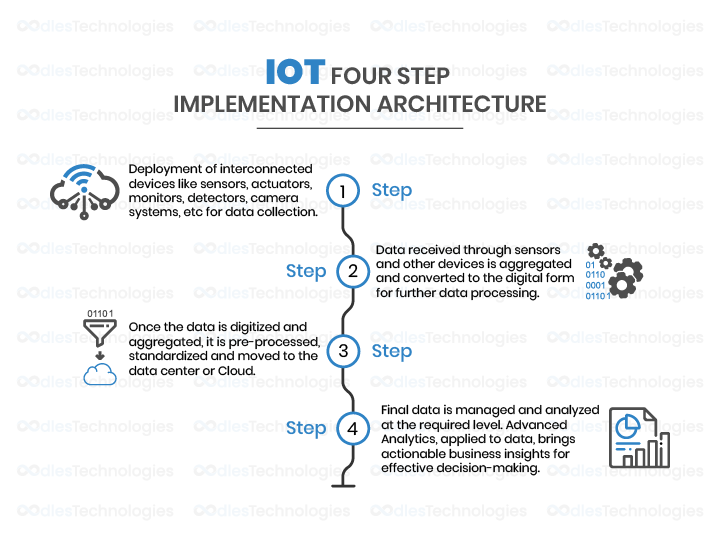Using IoT for In Home Patient Care
Posted By : Khushboo Arora | 05-Sep-2019

Recent technological refinements in healthcare are enabling patients to receive on-time and tailored treatments. But the cost of basic healthcare is so high that the majority of patients cannot benefit from the latest developments. Implementing IoT solutions to healthcare has not only brought persistency but has enabled patients to avail of real-time diagnosis and treatment. Home health monitoring devices like defibrillators, scales, insulin pumps, CPAP machines, cardiac monitoring devices, and oxygen tanks are connected with IoT devices to update doctors/caregivers about their patient's health in real-time.
IoT enabled wearable devices like fitness bands are marketed as wellness solutions. Fitness bands or smartwatches collect vital health statistics throughout the day and transmit them wirelessly to smartphones, tablets, or computers.
The following use cases demonstrate how IoT is improving in-home patient care solutions:
-
Ingestible Sensors: Proteus Digital Health has developed a system consisting of a sensor patch, a pill, and a smartphone. The one-square-millimeter sensor pill is coated with digestible metals like copper and magnesium. Upon swallowing, the sensors are activated by electrolytes within the body. These sensor pills transmit signals to the battery-powered patch worn by the users on their bodies. The data collected through these sensors are transferred to caregiver’s smartphones for regular updates. Ingestible pills can resolve problems surrounding chronic diseases to eliminate the need for endless checkups.
-
Moodables: Various software development companies have come up with mood-enhancing devices to alter the mood of patients with anxiety issues. Head-mounted wearable devices send low-intensity current to the brain designed specifically for elevating patient mood. In some cases, they even replace and reduce the dosage of antidepressant medications. These devices also claim to improve relaxation and curb problems of people with ADD or stress disorder.
-
Hearable Devices: BioSport hearable device is designed to track fitness metrics or biometric data using earbuds. The hearable device can track and monitor blood pressure, heartbeat, and other vital statistics. Patients with partial or complete deafness can use these wearables to amplify or obstruct selected sounds.
-
Automated Pill Dispensers: Smart medication dispensers are connected with patients, caregivers, pharmacists, healthcare professionals through online portals. These medicine dispensers are sold in a pre-programmed and pre-filled state as per the physician’s instructions. Doctors can change the settings of the dispenser on the basis of patients' real-time conditions. Karie is an automated, home-use, medication dispenser which when loaded with drug cartridge creates a medication schedule. When a patient is away, Karie re-schedules the medication and even alerts the users, caregivers’ on their smartphone about the same.
-
Sweat Sensors: IoT enabled sweat sensors are attached to a patient’s body to detect an increase in blood sugar levels and other ailments of the body. GraphWear Technologies makes a sweat assessment wearable patch that uses a person’s sweat to evaluate electrolyte and glucose levels in their body. The patch is useful for athletes and cricketers as it can alert them when it is time to replenish themselves with nutritional drinks.

Let’s explore how does the onset of IoT patient monitoring work towards the bigger picture of improving care delivery and outcomes.
-
Cost Reduction: IoT enabled wearable devices to remotely monitor patients’ health in real-time. It cuts down unnecessary visits to hospitals, doctors, and re-admissions.
-
Improved Treatment: Data received through wearable devices facilitate doctors in making evidence-based informed decisions. Heartbeats or pulse rate data collected through wearable devices can reduce the chances of a heart attack.
-
Faster Disease Diagnosis: IoT enabled ingestible sensor pills can constantly monitor what is happening inside a patient’s body. It critically evaluates the root cause of a problem for immediate prevention.
-
Proactive Treatment: Data gathered through IoT devices can be used to track physical activities a person performed at a specific time. A person with a track of sedentary lifestyle receives a notification that he/she needs to be active enough to eliminate the risk of heart diseases.
-
Drugs and Equipment Management: IoT sensors attached to the drugs can track how many medicines are available in stock. Sensors alert the desired pharmacists to deliver medicines before a stock is about to finish.
-
Error Reduction: Data generated by wearable devices can enable doctors to take the right decision at the right time. Doctors can use remotely generated data to reduce errors, wastage, and system costs.
Are you planning to use IoT solutions to improve your healthcare services? Oodles technologies provide IoT consulting and development services to customers across the globe. Our experienced IoT solution developers build apps for wearables including smartwatches, fitness bands, smart glasses and more. We provide enterprise-grade IoT app development services that include machine learning and advanced analytics. Our IoT Application Development Services provide business efficiency. We build smart products including home automation, security systems, industrial IoT and more. Contact us today!
Cookies are important to the proper functioning of a site. To improve your experience, we use cookies to remember log-in details and provide secure log-in, collect statistics to optimize site functionality, and deliver content tailored to your interests. Click Agree and Proceed to accept cookies and go directly to the site or click on View Cookie Settings to see detailed descriptions of the types of cookies and choose whether to accept certain cookies while on the site.











About Author
Khushboo Arora
Khushboo is a Technology enthusiast. As a content strategist , she has a great affinity for discovering and sharing unique insights and resources with the tech community.